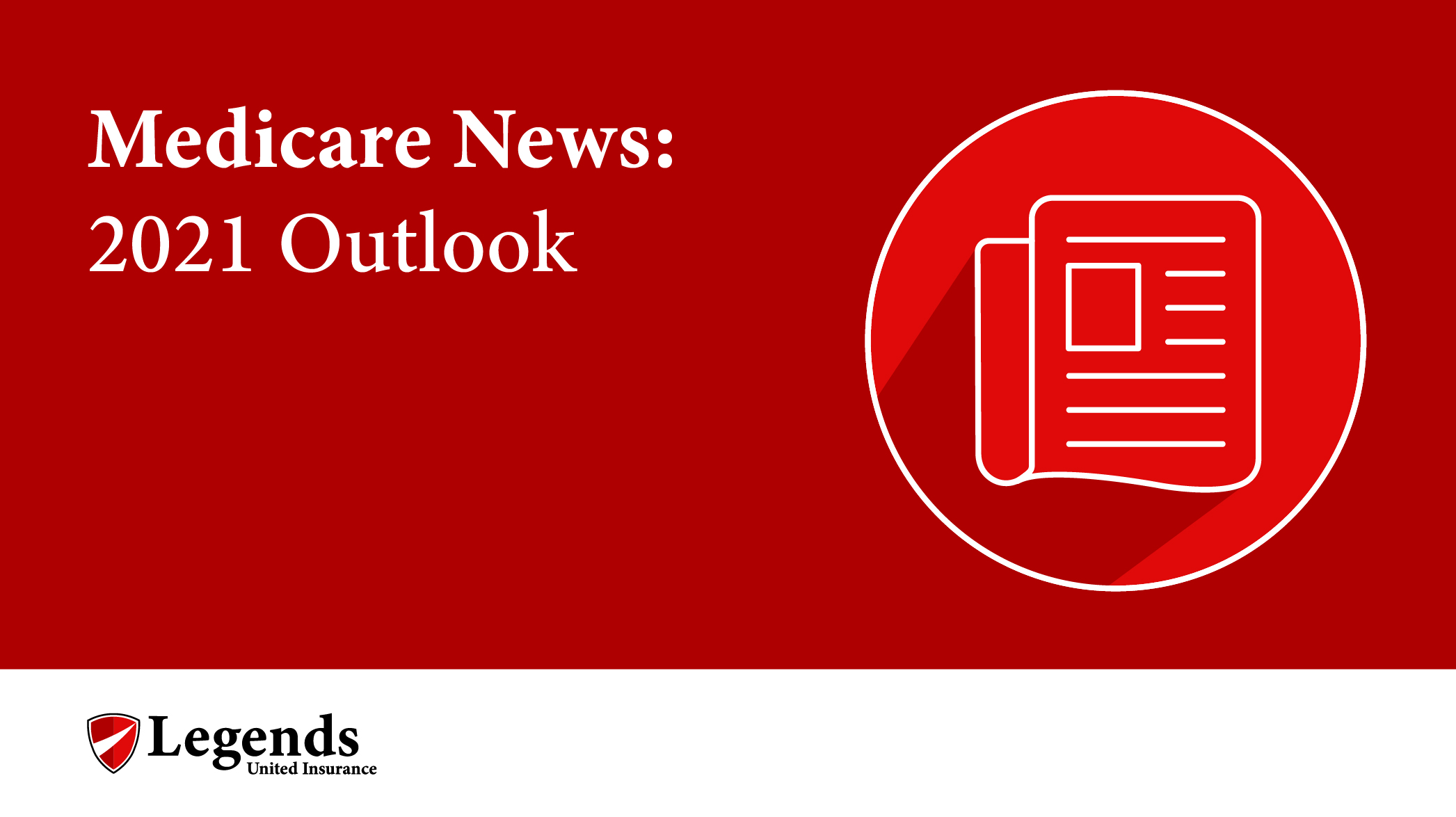
Medicare News: 2021 Outlook
It’s time to start thinking about 2021. On October 15, the fall Annual Election Period for Medicare will start, and enrollees will select their plans for the following year – and October will be here before you know it. In the meantime, here’s a look at what we can expect from Medicare in 2021.
Enrollment Numbers
There are more than 60 million Medicare beneficiaries, and every day, approximately 10,000 seniors turn 65 and become eligible for Medicare. This means that the number of beneficiaries is steadily increasing.
More and more of these enrollees have been turning to Medicare Advantage. According to Health Payer Intelligence, Medicare Advantage enrollment has doubled in the last 10 years. More than one-third of all Medicare beneficiaries are now enrolled in Medicare Advantage plans, and this figure is expected to continue rising over the next decade.
With both a greater number of people who are eligible for Medicare and a greater number of people who are interested in Medicare Advantage, the enrollment numbers for 2021 can be expected to be high.
Prescription Costs
CMS has announced that the average basic Part D premium is expected to be $30.50 in 2021. This is only slightly higher than the 2020 average basic Part D premium of $30, which was the lowest that the Medicare Part D premium had been since 2013.
Medicare enrollees with diabetes will see additional savings due to the availability of insulin that costs no more than $35 per prescription in some plans. CMS estimates that beneficiaries could save an average of $446 in out-of-pocket savings as a result. Approximately 20 percent of Americans aged 65 or older have diabetes, so this will impact a significant number of Medicare enrollees.
End-Stage Renal Disease
The Cures Act included a change that allows Medicare beneficiaries with End-Stage Renal Disease (ESRD) to enroll in Medicare Advantage plans starting in 2021. CMS says that certain payment changes have been made to go along with this new rule, including fee-for-service coverage of kidney acquisition costs for Medicare Advantage beneficiaries and the exclusion of these costs from Medicare Advantage benchmarks.
This new rule means that Medicare enrollees with ESRD will have many more options for coverage, while Medicare Advantage plans may see an influx of ESRD patients who were previously prohibited from enrolling.
CMS has also proposed Medicare payment changes that would support access to home dialysis. Currently, more than 85% of Original Medicare beneficiaries with ESRD go to a dialysis center at least three times a week, and this population has the highest rate of hospitalization. Because of the COVID-19 pandemic, seeking care in medical facilities could put this vulnerable population at increased risk, and at-home dialysis is seen as a safer alternative.
Telehealth Coverage
Telehealth coverage had been gaining popularity before the COVID-19 pandemic, and now it’s catching on even faster than many anticipated.
Back in 2019, CMS finalized a rule that allowed Medicare Advantage plans to offer additional telehealth benefits. “With these new telehealth benefits, Medicare Advantage enrollees will be able to access the latest technology and have greater access to telehealth. By providing greater flexibility to Medicare Advantage plans, beneficiaries can receive more benefits, at lower costs and better quality,” said CMS Administrator Seema Verma.
Another rule change, this one announced in May 2020, expanded Medicare Advantage telehealth options even further. Under the new rules, Medicare Advantage plans have more flexibility to count telehealth providers in certain specialties as meeting the CMS network adequacy standards. These specialties include psychiatry, primary care, dermatology, endocrinology and more.
Although Original Medicare’s telehealth coverage had been much more restrictive, this has changed somewhat in response to the pandemic. Medicare’s coronavirus response include the temporary expansion of telehealth services, including virtual check-ins that could be conducted from the patient’s home and the use of online portals to communicate with healthcare providers.
Many Medicare enrollees have taken advantage of these changes. According to Health Affairs, Medicare claims data shows that close to 1.7 million beneficiaries received telehealth services in the last week of April, and more than 9 million beneficiaries received telehealth care between mid-March and mid-June. Overall, 26% of Medicare-only beneficiaries and 34 % of dually eligible beneficiaries used telehealth services.
There has also been a legislative push to make Medicare’s telehealth expansion permanent. According to mHealth Intelligence, a growing number of bills make it clear that Congress is very interested in making Medicare’s telehealth coverage last beyond the current pandemic.
In addition to possible legislative changes that may be coming, attitude toward telehealth may be shifting. Although seniors are often stereotyped as being averse to technology, this is not always the case, and many seniors actually use technology regularly. For example, according to Pew Research Center, 42% of Americans aged 65 or older own a smartphone.
Now, more people may be embracing new technologies as the only way to stay connected while practicing social distancing – and once the pandemic is over, they may decide they want to continue using these convenient tools. According to Fierce Healthcare, recent survey found that 91 percent of seniors who used a telehealth service had a favorable experience, and 78% said they planned to use telehealth services again.
Regardless of when the pandemic ends, it seems likely that telehealth will remain a popular benefit in 2021.
Medicare Costs
The COVID-19 pandemic has raised many questions regarding what Medicare Part B price hikes and Social Security benefit increases might – or might not – be in store for 2021.
Every year, the Social Security Administration announces its cost-of-living adjustment (COLA) for the following year. The COLA is based on inflation, and it determines how much more beneficiaries will receive each month. Often, the COLA is modest, and it may be largely eaten up by price increases for Medicare Part B premiums.
This year, the economic recession caused by the coronavirus pandemic has made many people wonder whether there will be any COLA at all for 2021. However, according to The Motley Fool, recent price increases suggest that retirees might get a COLA in 2021 after all. That’s good news for retirees who are counting on a benefit increase to keep up with their expenses.
But will the COLA be wiped out by Medicare Part B premium increases?
Maybe not.
Although some people had forecasted a premium hike in response to the coronavirus, new legislation could freeze Medicare Part B premiums at the 2020 levels. According to CNBC, this provision is included the Republican’s HEALS Act, the new relief bill, although the bill also has beneficiaries paying about $3 extra per month as a surcharge until the shortfall that will be caused by freezing premiums is recouped.
In 2020, the standard Medicare Part B premium is $144.60. Some Medicare enrollees pay more based on their income level, and some Medicare enrollees pay less because of the “hold harmless” rule that says premiums cannot increase by more than the Social Security COLA.
Star Ratings
The pandemic has also raised concerns regarding Star Ratings. Medicare Beneficiaries can use Star Ratings to evaluate Medicare Advantage and Medicare Part D Prescription Drug Plans. Plans receive a Star Rating of between one and five stars based on certain criteria measuring quality of care and service.
CMS says that certain policies have been created to replace any measures that have a systemic data quality issue due to COVID-19.
Looking Ahead
2020 has been full of many unexpected challenges. The COVID-19 pandemic has caused both a health crisis and an economic crisis, and Medicare enrollees are feeling the pressure on both fronts. The total impact of the coronavirus on Medicare and Social Security remains to be seen, but it is safe to say that the pandemic will have a major effect on these programs in 2021 and going forward.
At the same time, the pandemic is pushing certain innovations, especially in the realm of telemedicine and home-based medical care, forward, with potential advantages for Medicare beneficiaries.
Having a forward-thinking Medicare FMO by your side is more important than ever before. Learn more about the many advantages of partnering with Legends United.
Want to speak with one of our Licensed Agents today? Click to Call below!




